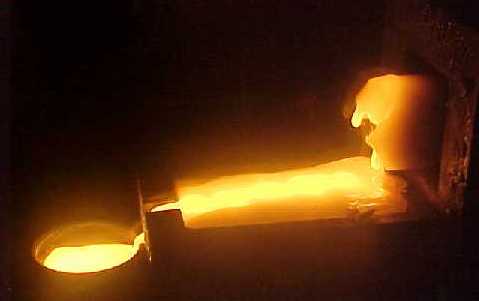What is titanium alloy cold-hearth melting?
Titanium alloy cold hearth melting is one of the most commonly used methods for titanium alloy semelting, the other of which is vacuum arc remelting (VAR).
Titanium alloy cold-hearth melting is a process in which a titanium alloy is melted in a copper water-cooled hearth using a plasma arc or an electron beam as a heat source. After the metal is smelted, it flows from the hearth into the crucible to form an ingot having a good surface quality.

Electron beam cold-hearth melting
Compared with the other titanium alloy smelting technology, VAR, electron beam cold-hearth melting has many advantages:
1 It can utilize various forms of raw materials such as residual materials, loose titanium sponge and titanium shavings, and economical raw materials;
2 It can remove impurities in the titanium alloys such as high-density purities, low-density impurities and volatile impurities, so it is an important technology for the purification of titanium alloy materials;
3 It can improve the yield of metals by producing ingots of various cross sections.
In recent years, the development of electron beam cold bed furnace smelting technology is mainly manifested in the following aspects: 1 titanium sulphide directly smelting titanium ingot; 2 numerical simulation technology; 3 single alloy ingot smelting technology; 4 ingot surface melting repair technology; 4 large hollow ingot production technology.
Plasma beam cold-hearth melting
The plasma beam cold-hearth smelting technique utilizes a concentrated, controllable, and stable plasma arc to provide a smelting method for the heat source.
The plasma beam cooling bed smelting prevents the volatilization of higher volatility elements such as manganese (Mn) and tin (Sn) when smelting the titanium alloy, and precisely controls the element content of the titanium alloy; it can generate a high-speed and rotating ion beam, thereby the titanium alloy composition is more uniform. In addition, the plasma working environment is close to atmospheric pressure and thus is not limited by the raw materials; the plasma cold-hearth melting pool is large and deep, so that the solution can be fully diffused.
At present, titanium alloys produced by plasma cold-hearth melting technology have been widely used in the engines of US military aircraft.
Please visit https://www.sputtertargets.net/ for more information.
Related:
What is the commercial value of titanium? - Quora
How was titanium discovered? | History of Titanium – SAM Sputter Targets
Basic Requirements of High Quality Titanium Sputtering Target – SAM Sputter Targets